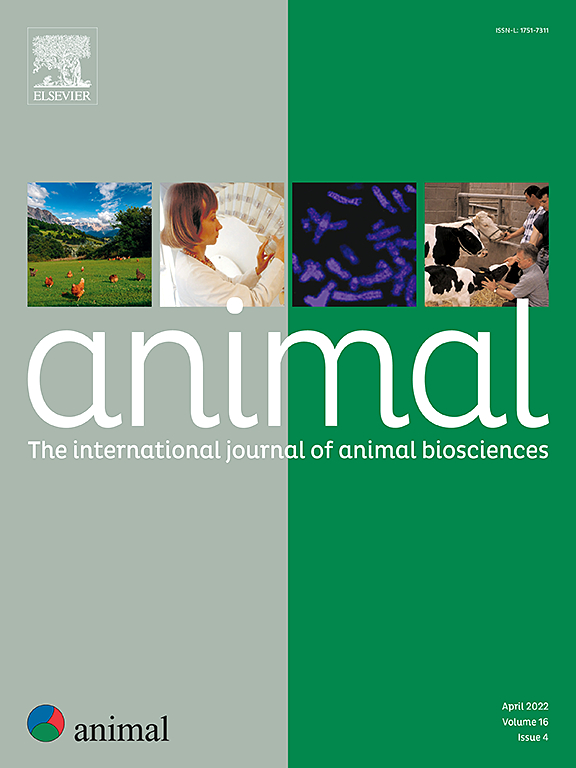The impact of the dairy cow’s position on eye and udder temperatures obtained with infra-red thermography within a walk-trough system
IF 4.2
2区 农林科学
Q1 AGRICULTURE, DAIRY & ANIMAL SCIENCE
引用次数: 0
Abstract
Infra-red thermography (IRT) has the potential to detect disease, injury, and stress in dairy cows. Using IRT as a routine early warning system for such issues on-farm requires highly frequent imaging, which typically needs automation. To this end, automated systems collecting data every time an individual passes through a specified area have been developed (walk-through systems). Within these, the animal’s speed, exact path and posture affect its distance and angle from the camera. While such variation in positioning is known to impact recorded temperatures, the extent of this impact is rarely quantified. If the error due to suboptimal positioning is sufficient to obscure temperature changes associated with the condition to be detected, the reliability of an early warning system is greatly impaired. This study aimed to quantify the impact of positioning on IRT-derived temperatures. Multiple IRT images were obtained from 197 lactating Holstein-Frisians using a walk-trough system. We assessed specific body parts chosen for their practical relevance: the eye centre (used to detect stress or general ill-health) and udder and teat area (used to detect mastitis or teat stress). The location of the body part within the IRT image (“position category”) was used as a measure for combined changes in distance and angle of incidence. Minimisation of each of these two factors results in a maximisation of recorded temperature but was expected to occur at different position categories. Position category affected the recorded temperature of all three body parts on both sides of the cow (P < 0.0001). Temperatures peaked in position categories where distance was not yet fully minimised, underlining the importance of the angle of incidence. In images taken from the left side, recorded eye temperature showed a 2.2 °C (± 0.17 SEM) difference between the position where it peaked and the position where it bottomed out. This difference was 2.0 (± 0.07) and 1.5 (± 0.08) °C for maximum udder temperature and maximum teat area temperature, respectively. On the right side, these differences were 2.2 (± 0.28), 1.1 (± 0.11) and 0.6 (± 0.14) °C. The differences in temperature due to dairy cow positioning could mask the onset of a health problem, as these result in an approximately equal temperature rise. This suggests that even though walk-through systems standardise positioning to some extent, further standardisation is required. Our findings are not only of direct importance for the further development of walk-trough systems but also provide an insight into the optimisation of positioning when imaging freely moving animals.
奶牛的位置对眼睛和乳房温度的影响,通过红外热像仪在走槽系统中获得
红外热像仪(IRT)具有检测奶牛疾病、损伤和应激的潜力。使用IRT作为农场此类问题的常规预警系统需要高度频繁的成像,这通常需要自动化。为此目的,已经开发了自动系统,每次在个人通过指定区域时收集数据(walk-through系统)。在这些范围内,动物的速度,确切的路径和姿势会影响它与相机的距离和角度。虽然这种位置的变化已知会影响记录的温度,但这种影响的程度很少被量化。如果由于次优定位引起的误差足以模糊与待检测条件相关的温度变化,则早期预警系统的可靠性将大大受损。本研究旨在量化定位对红外热成像衍生温度的影响。采用走槽系统从197例哺乳期荷斯坦-弗里斯兰犬中获得多幅IRT图像。我们根据实际情况评估了选定的特定身体部位:眼中心(用于检测压力或一般健康状况不佳)和乳房和乳头区域(用于检测乳腺炎或乳头压力)。身体部位在IRT图像中的位置(“位置类别”)被用作距离和入射角组合变化的度量。最小化这两个因素中的每一个都会导致记录温度的最大化,但预计会发生在不同的位置类别。体位类别影响奶牛两侧所有三个身体部位的记录温度(P <;0.0001)。温度在距离尚未完全最小化的位置类别中达到峰值,强调了入射角的重要性。在从左侧拍摄的图像中,记录的眼睛温度在峰值位置和最低点位置之间相差2.2°C(±0.17 SEM)。最高乳房温度和最高乳房区域温度的差异分别为2.0(±0.07)和1.5(±0.08)°C。在右侧,这些差异分别为2.2(±0.28),1.1(±0.11)和0.6(±0.14)℃。由于奶牛的位置不同,温度的差异可能掩盖了健康问题的发生,因为这导致了大致相同的温度上升。这表明,尽管演练系统在一定程度上标准化了定位,但还需要进一步标准化。我们的发现不仅对行走系统的进一步发展具有直接的重要性,而且还提供了对自由移动动物成像时定位优化的见解。
本文章由计算机程序翻译,如有差异,请以英文原文为准。
求助全文
约1分钟内获得全文
求助全文
来源期刊

Animal
农林科学-奶制品与动物科学
CiteScore
7.50
自引率
2.80%
发文量
246
审稿时长
3 months
期刊介绍:
Editorial board
animal attracts the best research in animal biology and animal systems from across the spectrum of the agricultural, biomedical, and environmental sciences. It is the central element in an exciting collaboration between the British Society of Animal Science (BSAS), Institut National de la Recherche Agronomique (INRA) and the European Federation of Animal Science (EAAP) and represents a merging of three scientific journals: Animal Science; Animal Research; Reproduction, Nutrition, Development. animal publishes original cutting-edge research, ''hot'' topics and horizon-scanning reviews on animal-related aspects of the life sciences at the molecular, cellular, organ, whole animal and production system levels. The main subject areas include: breeding and genetics; nutrition; physiology and functional biology of systems; behaviour, health and welfare; farming systems, environmental impact and climate change; product quality, human health and well-being. Animal models and papers dealing with the integration of research between these topics and their impact on the environment and people are particularly welcome.
 求助内容:
求助内容: 应助结果提醒方式:
应助结果提醒方式:


